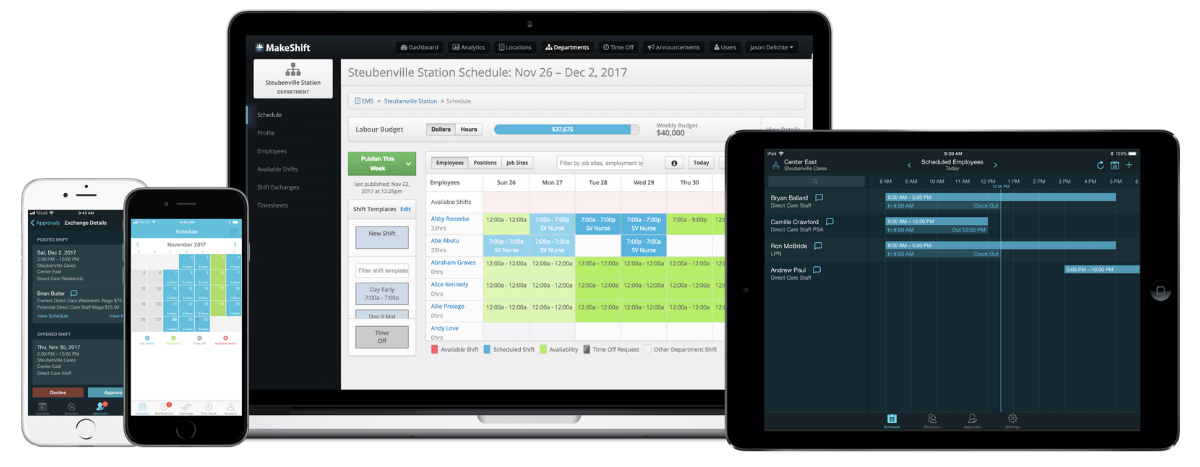Welcome to the future of work.
Because the chaos of last-minute schedules is as outdated as flip phones and fax machines.
Predictive scheduling is the modern-day crystal ball of workforce management, minus the mystical woo-woo stuff.
This isn't just about knowing who's on shift next Tuesday — it's about transforming your workplace into a well-oiled machine where employee satisfaction and operational efficiency go hand in hand.
Today, we’ll cover how predictive scheduling benefits you and your employees, plus how to implement it in your organization.
- What is Predictive Scheduling?
- Predictive Scheduling vs. Old School Scheduling
- Benefits of Predictive Scheduling
- How To Implement Predictive Scheduling
- A Case Study on Predictable Schedules
- How MakeShift Can Help You Implement Predictive Scheduling
What is Predictive Scheduling?
Predictive scheduling is a workforce management approach that emphasizes providing employees with stable and predictable work schedules.
It represents a significant shift from the chaotic, unpredictable old-school scheduling methods. At its core, predictive scheduling is about providing employees with stable, predictable work schedules.
This especially makes a big impact on the lives of employees with on-call scheduling.
These employees make up a large portion of the shift worker pie.

According to the Economic Policy Institute, at least 6% of hourly workers, 8% of salaried workers, and 30% of other employees work on-call shifts.
Today, Oregon is the only state with a statewide law concerning predictive scheduling, and it’s still mighty limited. The law only affects “employers in the retail, hospitality, and food service industries with at least 500 employees.”
Larger cities like Philadelphia, New York, Chicago, and San Fransico have predictive scheduling laws for some but not all industries.
Predictive Scheduling vs. Old School Scheduling
To fully appreciate the impact of predictive scheduling, let’s compare it with traditional scheduling methods. Here’s how predictive scheduling differs from the old-school approach.
Predictive Scheduling
We’ve laid out a predictive scheduling system's baseline nuts and bolts.
- Advance Notice — Employees receive their work schedules well in advance, typically 2 to 4 weeks before the start of the work period. This lets them proactively plan their personal lives.
- Stable Hours — Schedules are more consistent week-to-week, with fewer last-minute changes related to poor shift planning. This stability allows for more work-life balance and reduces work-related stress.
- Shift Assignments Predictability — Shift assignments are based on predictive models that factor in historical data, employee preferences, and business needs, leading to more fair and predictable shift distribution.
- Compliance — In areas that have legal requirements for employee scheduling, employers must adhere to specific rules about:
- Scheduling notice
- Pay for canceled shifts
- Changes made after the schedule is posted
- Compensation for Changes — If you make changes after the initial schedule is posted, your employees may be entitled to extra pay to compensate for the inconvenience.
Believe it or not, this is good for YOU and your employees.
This requirement nudges you to put more thought into the original schedule — when you do this, there’s usually less shift swapping due to availability.
And, if the schedule has to change, your employees know they’ll be compensated for the inconvenience, which keeps you in their good graces.
Traditional Scheduling
We’re talking about flying by the seat of your pants scheduling here. Old-school, manual scheduling was more reactive than proactive.
- Short Notice — Traditional scheduling often involves doling out schedules with little notice, sometimes only a few days in advance. This creates uncertainty for employees, both financially and in planning their lives.
- Variable Hours — Employees may experience significant variability in their work hours from week to week, making planning for other commitments difficult (or almost impossible).
- Reactive Shift Assignments — Shifts are often assigned based on short-term needs without consistent patterns, leading to unpredictable work hours.
- Lack of Regulation Adherence — Traditional scheduling practices are not typically governed by predictive scheduling laws, giving employers more flexibility but less structure in managing employee schedules.
- Less Compensation for Changes — Employees are usually not compensated for schedule changes or last-minute cancellations in traditional scheduling systems.
Benefits of Predictive Scheduling
Rather than thinking of predictive scheduling as a “have to,” focus on WHY you should adopt this practice.
Our #1 reason?
It’ll change your workplace culture for the better.
6 Benefits for Managers
1. Improved Efficiency — By accurately predicting staffing needs, you’ll optimize workforce allocation, ensuring the correct number of employees are scheduled when needed most.
2. Reduced Labor Costs — Predictive scheduling helps minimize overstaffing or understaffing, which equals more efficient labor cost management.
3. Enhanced Compliance — Following predictive scheduling regulations helps avoid legal penalties and maintains your company's compliance with local labor laws.
4. Modernized Employee Management — Predictable schedules make handling leave requests, shift swaps, and other scheduling complexities easier. Especially when using staff scheduling software.
5. Increased Employee Satisfaction & Productivity — When employees are happier with their work schedules, they’re more productive and engaged, creating a more cohesive workplace vibe.
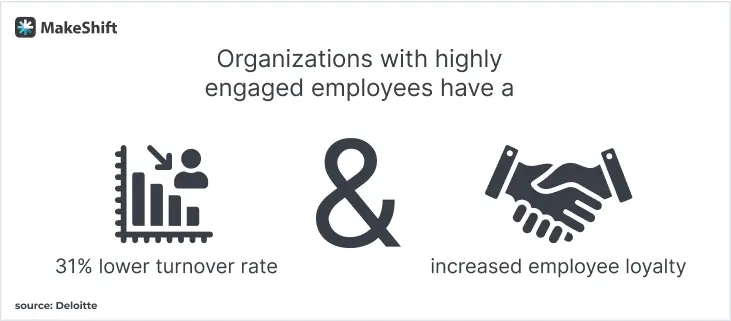
Companies with highly engaged employees have a 31% lower turnover rate and stronger employee loyalty than companies that don’t focus on employee engagement.
6. Data-Driven Decision-Making — Predictive scheduling uses data analytics to forecast staffing needs, leading to more informed and strategic decision-making.
AI-powered staff scheduling platforms make this happen automatically
6 Benefits for Employees
1. Work-Life Balance — Receiving schedules in advance allows your employees to plan their personal lives better, improving their work-life balance. Use staff scheduling software to enhance this by making schedule management easier and more transparent.

Work-life balance isn’t optional for most employees today — 65% of employees say the pandemic made them rethink the place work should have in their lives.
2. Reduced Stress & Uncertainty — Predictable work hours reduce the stress and uncertainty associated with fluctuating and inconsistent schedules.
3. Fairer Shift Distribution — Predictive scheduling models ensure a more equitable distribution of shifts, reducing potential perceived favoritism or bias in scheduling.
4. Increased Job Stability & Satisfaction — You don’t have to be a rocket scientist to grasp how stable work hours lead to more job satisfaction. When employees feel secure in their roles and valued by their employer, that affects their attitude toward their work.
5. Opens up Opportunity — Knowing their schedule in advance allows your employees to pursue further education, a 2nd job, or a hobby.
6. Financial Stability — This should probably be #1, but life isn’t all about money, right? Although we dare you to say that to someone struggling financially — they may throw you headfirst into a trash can.
The predictable income from consistent work hours helps in better financial planning and stability for employees.
If they can depend on you to schedule them for consistent work, odds are they’ll stick around.
How To Implement Predictive Scheduling
Implementing predictive scheduling in your workplace involves several key steps.
Adopting staff scheduling software to streamline the process and enhance its effectiveness will get the ball rolling even faster.

The employee scheduling software market is on track to grow at 12.6% a year as more companies optimize their scheduling processes.
1. Understand Legal Requirements
Before implementing predictive scheduling, you must understand local or state laws that might apply to your business. Double-check your scheduling practices to ensure compliance with these regulations.
We’ve created a quick resource list for known predictive scheduling laws in the U.S. and Canada. Feel free to copy it and use it as your own.
2. Assess Current Scheduling Practices
Review your current scheduling methods to identify areas that need improvement.
Consider how changes in scheduling could impact your daily operation, employee morale, and customer service.
4 areas to kick off your assessment could be:
- Scheduling Efficiency — How quickly and accurately schedules are created and distributed? Look for bottlenecks or delays in the process.
- Flexibility & Responsiveness — How well does your scheduling system accommodate last-minute changes or unexpected staffing needs? How easy is managing shift swaps or covering absences?
- Employee Turnover & Absenteeism — Track patterns in turnover and absenteeism, which can often be linked to scheduling practices.
- Customer Service Impact — Consider how scheduling affects customer service. Do your staffing levels meet customer demand without compromising service quality?
3. Engage with Employees
Chat with your employees to understand their needs and preferences regarding work schedules. Their input can be invaluable in creating schedules that are fair and functional.
Try these open-ended questions to get employee feedback:
- How would you rate your satisfaction with the current scheduling process, and why?
- Are your personal scheduling needs and preferences adequately considered in the current process?
- Are there any specific challenges or difficulties you frequently encounter with the current scheduling system?
- What improvements or changes would you suggest for the scheduling process?
- How do you feel about the communication process regarding schedule changes or updates?
4. Select Staff Scheduling Software
Choose a staff scheduling software that fits your business's size and industry.
Look for features like:
- Automated schedule generation
- Easy shift swaps
- Real-time updates
- Compliance tracking
- Analytics capabilities
- HIPPA compliance (if applicable)
Wondering if your staff’s on board with technology?
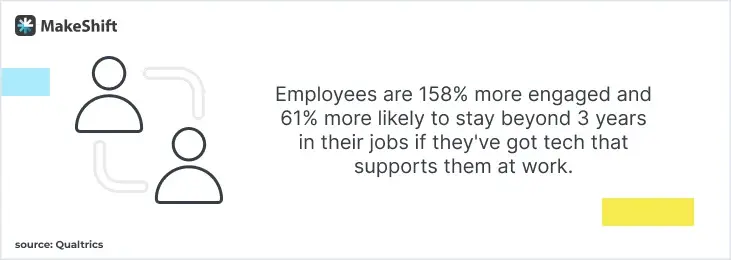
Spoiler alert — they are.
Employees are 158% more engaged and 61% more likely to stay beyond 3 years in their jobs if they feel they’ve got tech that supports them at work.
5. Train Management & Staff
Ensure management and staff are trained in using the new scheduling software.
They should understand:
- How to access their schedules
- Request (& approve for managers) time off
- Swap shifts
- View availability shifts
- Set their availability
- Use AI-scheduling platform if available
- Communicate
- Clock in & out
6. Implement Advance Scheduling
Start creating schedules in advance, ideally 2 to 4 weeks before the work period.
This advance notice helps employees plan their personal lives and reduces scheduling conflicts.
Before implementing, be sure you have a scheduling policy that complies with local labor laws.
Create and communicate your policy regarding:
- How far in advance schedules will be made
- When employees should have their availability set
- How shift swaps are handled
- Time off request policy
Note: These last 4 steps don’t require as much detail, but they’re just as important as the first 6.
7. Establish Clear Communication Channels
Set up efficient communication channels for schedule distribution, updates, and feedback. Ensure that employees are promptly notified of any schedule changes.
Any scheduling software worth a hoot makes communication simple and easily accessible.
8. Monitor and Adjust Scheduling Practices
Use the analytics and reporting tools in your scheduling software to monitor the effectiveness of your predictive scheduling practices.
Look for trends in employee attendance, punctuality, productivity, and any operational challenges.
9. Solicit Regular Feedback
Regularly ask for feedback from employees and managers on the new scheduling system. This feedback is crucial for making necessary adjustments and improvements that benefit your entire organization.
10. Stay Adaptive and Flexible
Be ready to adapt your scheduling practices as your business needs change. The goal is to balance predictability for employees and flexibility for your business.
A Case Study on Predictable Schedules
Predictable schedules make an impact. Read on to see how the Gap increased employee input and productivity by making staff schedules more predictable.
The study found that fluctuations in customer demand weren’t the leading cause of scheduling instability, as initially assumed.
Instead, factors like inaccurate shipment info, last-minute promotional changes, and visits from corporate headquarters were bigger culprits.
Overview:
A study on predictable scheduling was conducted from March 2015 to August 2016 at Gap stores. Initially, 3 stores in San Francisco tested the approach for 7 months.
Gap implemented two key practices across all U.S. stores:
- Two-week advance notice on schedules
- On-call shifts were eliminated
Expanded Pilot:
The 1st pilot involved 28 stores in San Francisco and Chicago. In this phase, 9 randomly assigned stores were designated control stores, while 19 other stores were designated pilot stores.
The pilot stores received additional scheduling interventions, including:
- Tech-Enabled Shift Swapping — Associates could swap shifts using an app, reducing manager involvement.
- Consistent Shift Times — Shift start and end times were made more consistent.
- Regular Scheduling — Efforts were made to standardize associates' shift days and times.
- Guaranteed Hours for Part-Timers — A group of part-time associates were guaranteed at least 20 hours per week.
- Strategic Staffing — Additional staff was allocated based on sales floor requirements at no extra-budgetary cost.
Key Findings:
The new scheduling practices improved consistency, predictability, and employee input.
Most employees, except those on guaranteed hour contracts, didn't see increased work hours.
Sales in the pilot stores jumped by 7%, and labor productivity increased by 5%, with these stores earning an additional $6.20 per labor hour compared to control stores.
Read the full report here.
How MakeShift Can Help You Implement Predictive Scheduling
MakeShift was developed from a people-first approach, so we naturally align with predictive scheduling that enhances your employees' well-being.
MakeShift scheduling supports predictive employee scheduling with key features:
ShiftMate AI Suite — Optimizes operations and employee wellness through generative AI-powered modules. Utilizes large language and graphical data models with machine learning tech for features like real-time assistance, automated scheduling, and predictive forecasting.
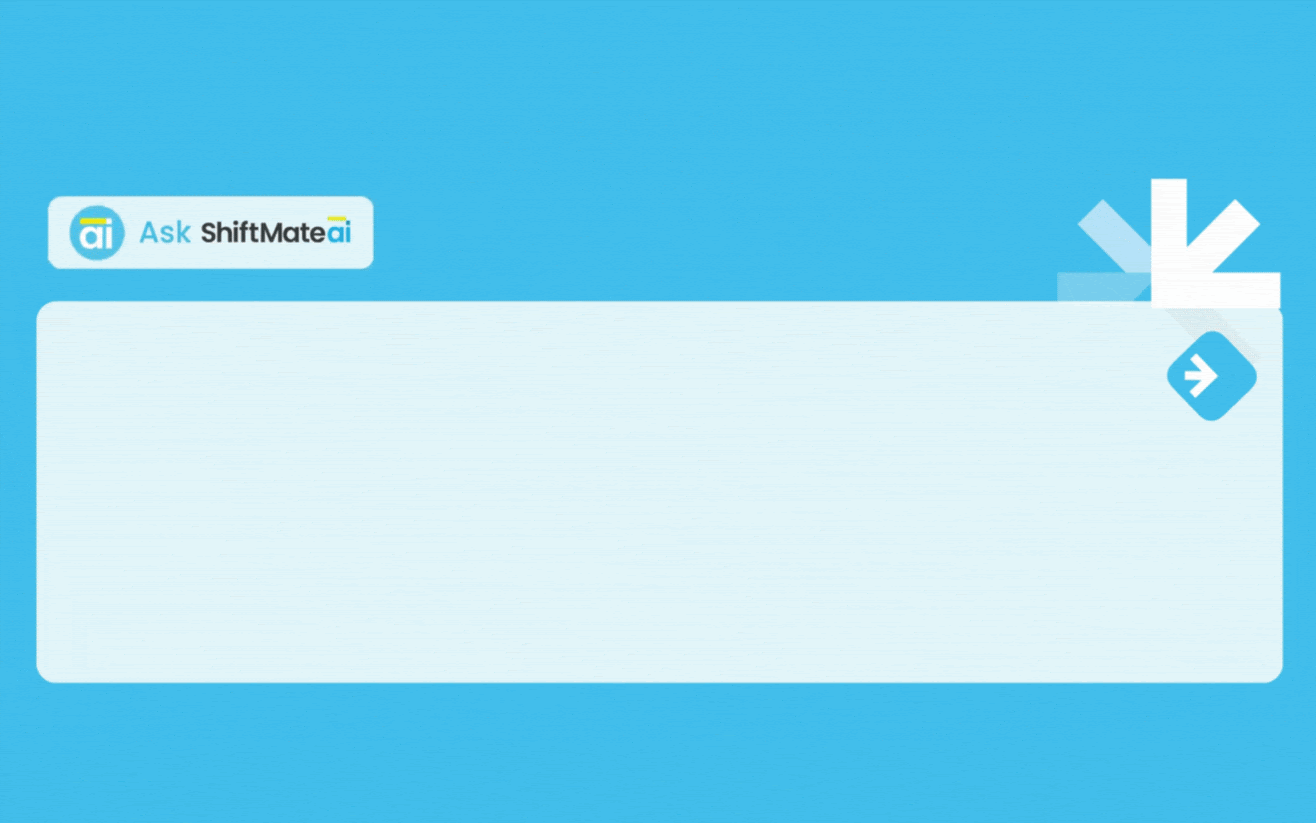
- SmartSupport — Provides 24/7 AI-powered assistance, offering real-time responses, step-by-step instructions, and scheduling tips.
- ShiftPredict — Uses AI to analyze historical data and other datasets, accurately predicting future scheduling needs while considering factors like employee wellness.
A schedule in their pocket — Easy access to the most up-to-date schedules. Our mobile app makes it simple to distribute an advance schedule. Employees can access their schedules on their phones wherever they are.

Team communication — Predictive scheduling is based on better communication and advance notice. Easily communicate with your team through our messaging app.
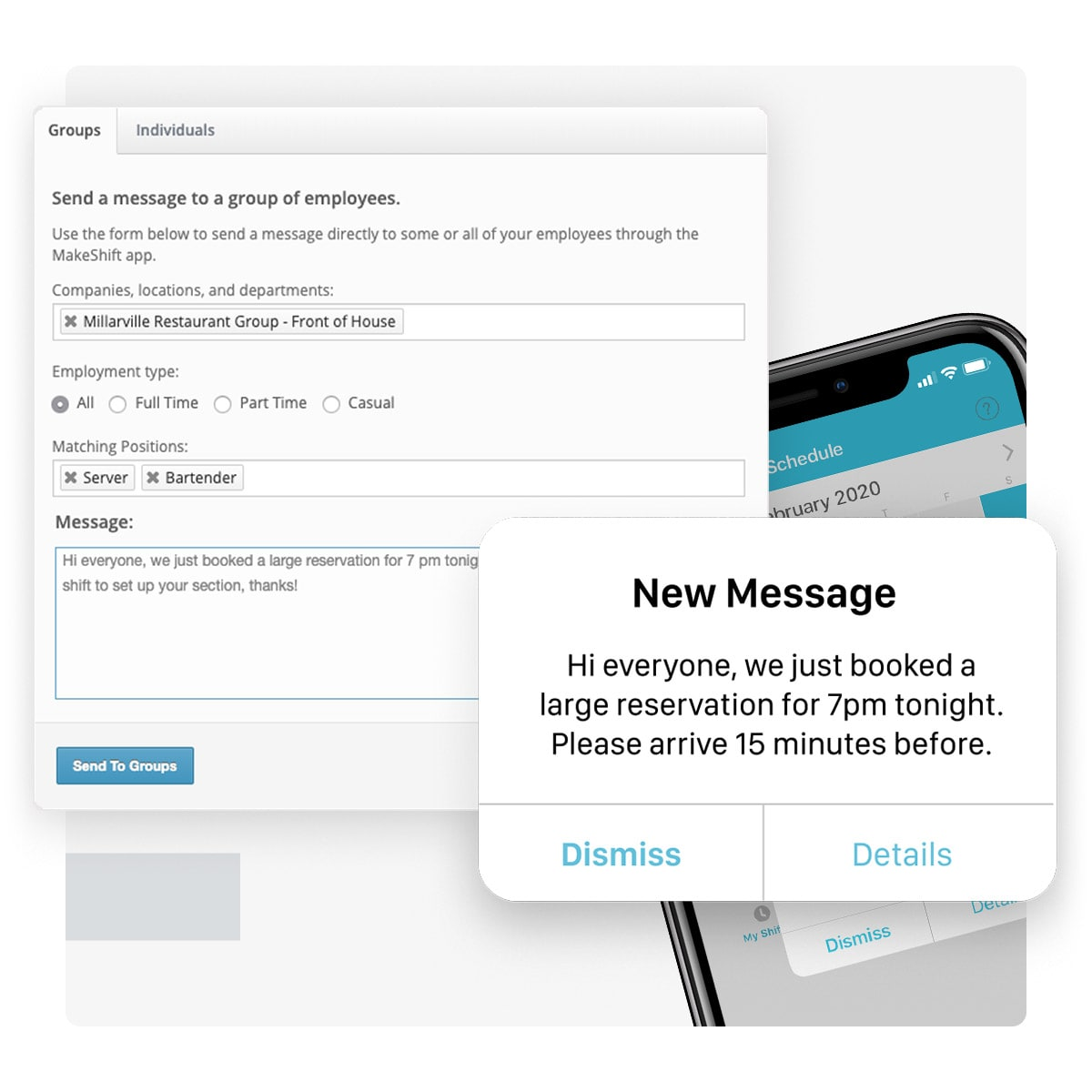
Predictive Scheduling — A Modern Scheduling Approach
Predictive scheduling isn't just a trend. It's a transformational approach to workforce management.
It aligns with the needs of the modern workforce, ensuring compliance, efficiency, and employee satisfaction.
Ready to see how MakeShift can help you stay compliant through predictive scheduling? Schedule a FREE demo today.




